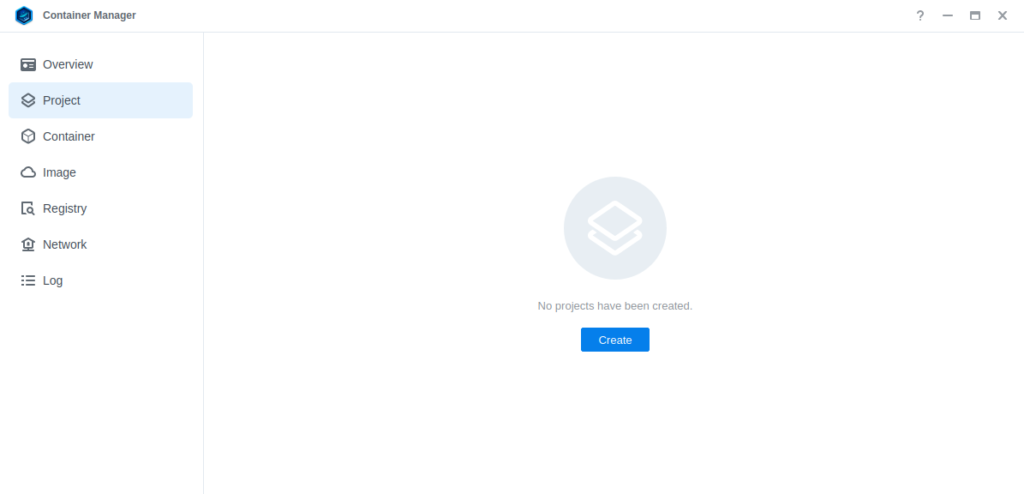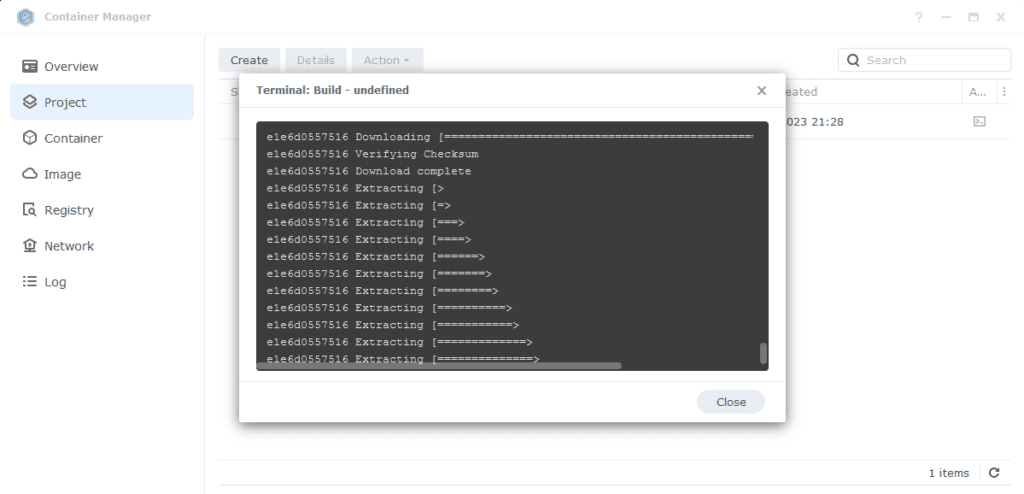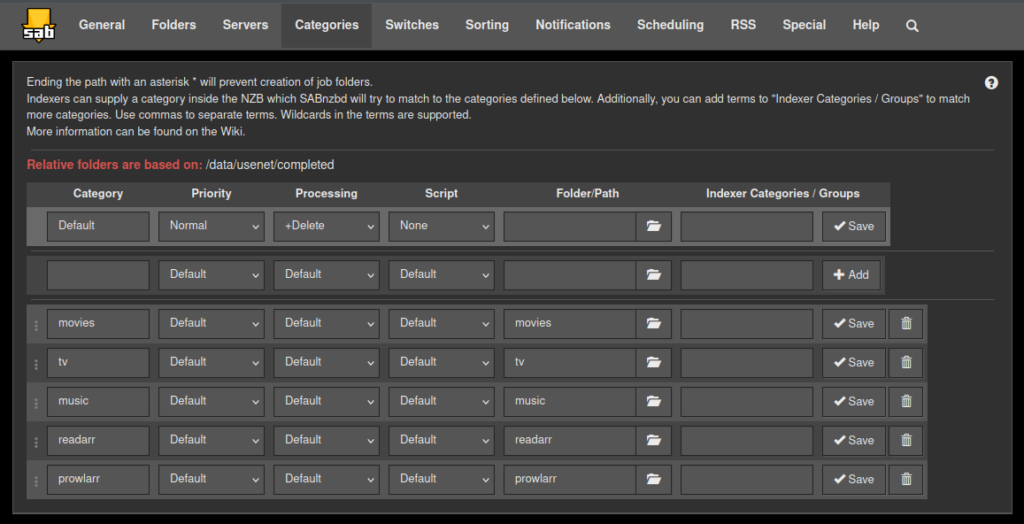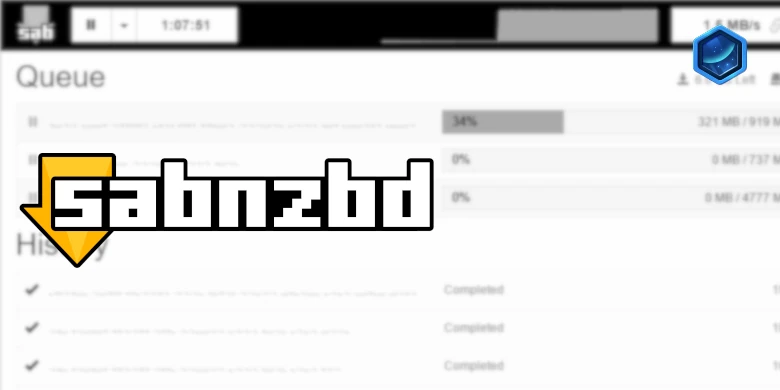Last updated on 28 February 2025
Important or Recent Updates
| Update | Date |
|---|---|
| New guide update for DSM7.2 and Container Manager | 06/05/2023 |
| Moved from UI setup to Project Setup which is more flexible and easier to maintain. | 21/10/2023 |
| Added an addition element to the compose to restrict the container from gaining additional privileges and also umask environment variable | 25/10/2023 |
What is SABnzbd?
SABnzbd is a binary newsreader, it is used to download files from Usenet, and where required will also repair and extract releases. It works on its own or in conjunction with other tools such as Lidarr and Radarr.
Useful external links for this guide
Linuxserver SABnzbd Container GitHub
SABnzbd Forums
SABnzbd Wiki
Let’s Begin
In this guide I will take you through the steps to get Sabnzbd up and running in Container Manager. We will be using the new Projects (Docker Compose) feature to get this running as it will save you time vs manual setup using the normal UI
In order for you to successfully use this guide please complete the three preceding guides
- Docker Package, SSD and Memory Recommendations
- Step 1: Directory Setup Guide
- Step 2: Setting up a restricted Docker user
- Step 3: Setting up a Docker Bridge Network (synobridge)
Folder Setup
Let’s start by getting some folders set up for the containers to use. Open up File Station create the following.
/docker/projects/sabnzbd-compose
/docker/sabnzbd
Container Manager
Next we are going to set up a ‘Project’ in Container Manager. Open up Container Manager and click on Project then on the right-hand side click ‘Create’.

In the next screen we will set up our General Settings, enter the following:
| Section | Setting |
|---|---|
| Project Name: | sabnzbd |
| Path: | /docker/projects/sabnzbd-compose |
| Source: | Create docker-compose.yml |

Next we are going to drop in our docker compose configuration, copy all the code in the box below and paste it into line ‘1’ just like the screenshot.
services:
sabnzbd:
image: linuxserver/sabnzbd:latest
container_name: sabnzbd
environment:
- PUID=1234 #CHANGE_TO_YOUR_UID
- PGID=65432 #CHANGE_TO_YOUR_GID
- TZ=Europe/London #CHANGE_TO_YOUR_TZ
- UMASK=022
volumes:
- /volume1/docker/sabnzbd:/config
- /volume1/data/usenet:/data/usenet
ports:
- 8080:8080/tcp
network_mode: synobridge
security_opt:
- no-new-privileges:true
restart: alwaysEnvironment Variables
We are now going to amend some key variables to make sure the container has access to our folders and also knows where we are in the world. Don’t change any other settings other than those I mention.
| Variable | Value |
|---|---|
| PUID | (required) The UID you obtained in the user setup guide |
| PGID | (required) The GID you obtained in the user setup guide |
| TZ | (required) Your timezone wikipedia.org/wiki/List_of_tz_database_time_zones |
Once you have made the edits you can click ‘Next’
You do not need to enable anything on the ‘Web portal settings’ screen click ‘Next’ again.

On the final screen click ‘Done’ which will begin the download of the container images and once downloaded they will be launched!

The image will now be downloaded and extracted. You should see ‘Code 0’ when it has finished.

Firewall Exceptions
(Skip if you don’t have the Firewall configured)
If you have the Synology Firewall enabled please see this additional guide for further info on exceptions and correct set up.
Some final steps
SABnzbd will now be running on port 8080 you can connect to it by going to the IP address of your NAS with that port
e.g. 192.168.0.40:8080
Once you have completed the setup wizard, go into the settings and amend your folders to the following
| Setting | Path |
|---|---|
| Temporary Download Folder | /data/usenet/intermediate |
| Completed Download Folder | /data/usenet/completed |
| Watched Folder | /data/usenet/nzb |

If you are using SABnzbd for your download client in the Arrs you will want to add some categories and paths as shown below. When adding SABnzbd to each of the Arrs match up the category in the download client settings, like the example below in Sonarr.
Categories will look like below, note that the path is purely the name of the folder with no other information, you will need to create each of the category folders in your usenet completed folder manually.


You are now configured to get downloads working, there are quite a few options in the configuration sections of the app that can both improve and hinder performance. These really depend on the capability of your NAS so keep this in mind.
Looking for some help, join our Discord community
If you are struggling with any steps in the guides or looking to branch out into other containers join our Discord community!
Buy me a beverage!
If you have found my site useful please consider pinging me a tip as it helps cover the cost of running things or just lets me stay hydrated. Plus 10% goes to the devs of the apps I do guides for every year.




Thanks Doc! Love your work. I’ve had problems with Sab (docker container) causing my server (DS420+) to lock up during unpacks, so I’m planning to get an M.2 drive and isolate all IO there so it doesn’t affect the performance of the RAID with the rest of the media and apps (Overseerr / Radarr / Sonarr / Plex). What’s the right way to configure this? I’m guessing I’d still install Sab on volume1, but I’d have to make the following changes:
1) Set up a separate volume2 on the M.2., and put the /usenet folder (and complete, incomplete, etc. subfolders) there instead
2) Install Sab per above guide, but row 12 of docker compose would say volume2 not volume1 (“/volume2/data/usenet:/data/usenet”)
3) Point to the correct folders in Sab setup after completing setup wizard
Any advice / corrections to the above? Thank you!
Hey
Your logic is sound, if you already have the ‘data’ share on volume1 then you can create a ‘downloads’ folder on /volume2/downloads/usenet:/downloads/usenet then pass that into the container and then dont forget to add this same exact path to the Arrs, so they can grab the downloads.
Sorry for the mails – I found the issue with Sabnzbd not restarting in the container. By default Sab enables IPV6 hosting… once I disabled that option in the sab special tab the app correctly restarts… looks like even though Docker has ipv6 disabled sab needs to have that flag unticked…. might be worth adding to the guide?
I wonder if they changed this as it’s disabled for me and I never turned it off. I will do a fresh setup and see what happens
Actually to my earlier message the forum posts on solving the sabnzb fails to restart don’t work for me at all. I’m running on 1019+ Synology with latest DSM 7.2 version…. followed the guide for Sab install but as soon as I click “Restart” within Sab I can no longer access sab until I restart the whole container in Container Manager.
I will test this out tomorrow then amend the guide/FAQ 🙂
There is currently this issue with Sabnzbd and Synology Containers that means once you follow this guide if you “restart” Sab within Sab’s settings UX you can no longer connect to Sab… (until you manually restart the container)
Fix is to do with the PATH variable. Need to delete it then reset container….
https://github.com/linuxserver/docker-sabnzbd/issues/188
Thanks, this is an old issue from when the PATH variable changed in the Container but back then the Docker package when set up via the UI it held onto the old path. It should not be an issue today at least from what I have seen.
Thanks for the guides! I’m migrating from an old set up I followed from your prior guides (non-atomic moves). However after SABNZB finishes and the movie or TV show is now in:
/data/usenet/completed
I actually want it to move movies to
/media/movies
and then TV shows to
/media/TV
(Which are where Plex monitors for new downloads to add to its library)
With this guide won’t I send up with all my SABNZ downloads in one folder with a mix of TV shows and Movies etc etc?
How do I get them to the right final folder depending on whether they are a TV show or a movie and preferably via atomic move?
The answer depends on if you are using Radarr, Sonarr to manage your media. What’s your overall setup?
Yes using Radarr and Sonarr per your prior guides… so they pass to SABNZB downloads usenet then I’d like to keep the final move in my /media/movies and /media/tv folders but per the new guides here I think that doesn’t work and it needs to be under the new /data folder you detail? Or can I leave in /media/.. etc? The folders are all on the same volume of the Synology.
OK you just need to make a couple of adjustments, make sure Sonarr and Radarr have /data mounted to them so they can reach into the folder and move the files to your /media share. This will avoid SAB making any file moves.
Thanks – But the benefit of me actually moving my existing /media/… folders under /data is that then Sonarr/Radarr would then ALSO be able to move the files without having to do a complete file copy and delete?
Yes correct 🙂